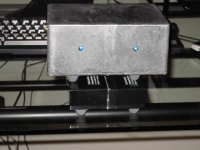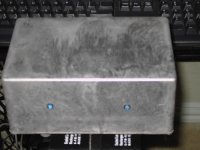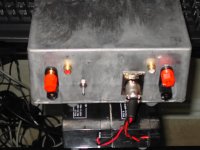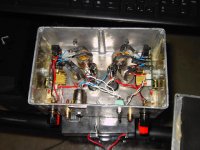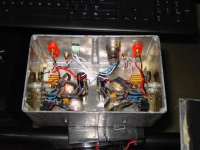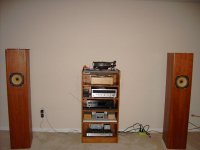Insides
The boards are mounted at each end of chassis. The extra filter caps are in the middle. The air core inductors inbetween.
The board have a pair of 330 ufd FM caps soldered to the power pins. The stock cpa has replaced with a 1200 ufd FM cap. Total capacitance measures at 9500 ufd per channel.
The input cap is a 2.2 ufd ceramic. The feedback is stock.
The box is lined with mumetal, for both shielding and mechanical dampening. The extra weight is nice.
The boards are mounted at each end of chassis. The extra filter caps are in the middle. The air core inductors inbetween.
The board have a pair of 330 ufd FM caps soldered to the power pins. The stock cpa has replaced with a 1200 ufd FM cap. Total capacitance measures at 9500 ufd per channel.
The input cap is a 2.2 ufd ceramic. The feedback is stock.
The box is lined with mumetal, for both shielding and mechanical dampening. The extra weight is nice.
Attachments
Whole System
This shows the new amp sitting on a Samsung HD-841 player, a Monica II dac, Marantz SA-8260 player, Pioneer TX-9100, Pearl phono, linestage, Micro Seiki DDX-1000, and Finally Lowther PM7A drivers in folded TQWT cabinets.
The amp usually sits on bottom by itself. Set it up to allow switching from Marantz to Monica quickly to compare sonics. Marantz wins for now.
George
This shows the new amp sitting on a Samsung HD-841 player, a Monica II dac, Marantz SA-8260 player, Pioneer TX-9100, Pearl phono, linestage, Micro Seiki DDX-1000, and Finally Lowther PM7A drivers in folded TQWT cabinets.
The amp usually sits on bottom by itself. Set it up to allow switching from Marantz to Monica quickly to compare sonics. Marantz wins for now.
George
Attachments
Dual Mono
It only uses one channel from each board. This does not increase the power. The two selected have the same dc offset, about 15 mv.
The boards share a common power supply when used as stereo. This one has a battery for each channel.
The unused channel has the input grounded at the 7 pin connector and a 10 ohm carbon comp resistor across the output to load it. The stock chokes were left in the inused channel.
The box does not get warm. It is a diecast aluminum box. The heat generated by the chips is very low. I cannot tell when it is on by touching the box.
The heatsinks were used because the later generation boards lack the solder slugs. The 2024 does get rather warm without the slugs. The heatsink barely gets warm. But I have heard reports of the latest SI's crapping out. I think maybe the 2024 is overheating.
George
Jim McPherson said:It looks like you've got 2 T-amps in there, yet only 2 speaker outputs. How do you achieve "dual mono" with 4 channels that are not bridgeable?
-Jim
It only uses one channel from each board. This does not increase the power. The two selected have the same dc offset, about 15 mv.
The boards share a common power supply when used as stereo. This one has a battery for each channel.
The unused channel has the input grounded at the 7 pin connector and a 10 ohm carbon comp resistor across the output to load it. The stock chokes were left in the inused channel.
The box does not get warm. It is a diecast aluminum box. The heat generated by the chips is very low. I cannot tell when it is on by touching the box.
The heatsinks were used because the later generation boards lack the solder slugs. The 2024 does get rather warm without the slugs. The heatsink barely gets warm. But I have heard reports of the latest SI's crapping out. I think maybe the 2024 is overheating.
George
Better sounding
Smoother, less colored. May be the better power from the dual batteries and the huge amount of in chassis low impedance caps.
The copper foil inductors may be helping also. They are 15 uH, came from Michael Percy. The are the 16 ga Solo. The 15 uH chokes work well with my 15 ohm speakers. The value of these needs to increase into higher impedance loads.
Have no idea how long it will run off two 2.3 aH batteries. Ran it for 8 hrs, and it was still going strong.
George
ohenry said:Very cool, those are some extreme mods. Any first impressions compared to the past stereo version(s)?
Smoother, less colored. May be the better power from the dual batteries and the huge amount of in chassis low impedance caps.
The copper foil inductors may be helping also. They are 15 uH, came from Michael Percy. The are the 16 ga Solo. The 15 uH chokes work well with my 15 ohm speakers. The value of these needs to increase into higher impedance loads.
Have no idea how long it will run off two 2.3 aH batteries. Ran it for 8 hrs, and it was still going strong.
George
Nice looking .....mods
Did you impliment the other standard mods [I should have read all the threads !]
I found one of the biggest gains was to use high quality wire [silver in my case].
I think a good qualiy mains supply is the way to go though IMO. Mind I only tried small batteries. I also had some big psu knocking about.
Did you impliment the other standard mods [I should have read all the threads !]
I found one of the biggest gains was to use high quality wire [silver in my case].
I think a good qualiy mains supply is the way to go though IMO. Mind I only tried small batteries. I also had some big psu knocking about.
Mods
George,
What did you do about the input coupling caps (C3, C4)? On mine I removed and jumpered them out and then removed R01 and R02. This paves the way to add quality off board caps spliced into the connection from the volume control wipers to the PCB input pins. Be careful to not cross channels. I left the inductors in and didn’t change the feedback resistors.
I found this upgrade really helps the frequency extremes as well as removing grunge and grain.
Roger
George,
What did you do about the input coupling caps (C3, C4)? On mine I removed and jumpered them out and then removed R01 and R02. This paves the way to add quality off board caps spliced into the connection from the volume control wipers to the PCB input pins. Be careful to not cross channels. I left the inductors in and didn’t change the feedback resistors.
I found this upgrade really helps the frequency extremes as well as removing grunge and grain.
Roger
Re: Mods
Roger,
Tried using 1 ufd film smd cap. But soldering them in ate my lunch. Ended up basck with 2.2 ufd ceramics. This is a 806 package. Could not get the 1210 package films soldered in.
I really like using film caps, but am trying to keep them on board for shielding.
I did use better quality wire for input. But left the standard SI witr for speakers. But seeing the series chokes on both sides it may be wasted.
The feedback resistors are stock also. The linestage used is very low gain so the system needs all it can get out of the amp.
George
sx881663 said:George,
What did you do about the input coupling caps (C3, C4)? On mine I removed and jumpered them out and then removed R01 and R02. This paves the way to add quality off board caps spliced into the connection from the volume control wipers to the PCB input pins. Be careful to not cross channels. I left the inductors in and didn’t change the feedback resistors.
I found this upgrade really helps the frequency extremes as well as removing grunge and grain.
Roger
Roger,
Tried using 1 ufd film smd cap. But soldering them in ate my lunch. Ended up basck with 2.2 ufd ceramics. This is a 806 package. Could not get the 1210 package films soldered in.
I really like using film caps, but am trying to keep them on board for shielding.
I did use better quality wire for input. But left the standard SI witr for speakers. But seeing the series chokes on both sides it may be wasted.
The feedback resistors are stock also. The linestage used is very low gain so the system needs all it can get out of the amp.
George
George,
I would recommend removing the .15uf caps from the speaker connectors if you haven’t yet. While you are at it you might as well change the wire out too. Use a non PVC type for best sound. I personally like the expanded polyethylene type. It does make a difference. Don't forget to twist the wires tightly together.
Hope you don't think I am being presumptuous, I'm not, just that this was a significant improvement for me. The cap removal was quite noticeable but not sure of the wire as I did them together first then clipped out the caps in a second unit. Never just changed the wire and listened to that change alone with these units.
Roger
I would recommend removing the .15uf caps from the speaker connectors if you haven’t yet. While you are at it you might as well change the wire out too. Use a non PVC type for best sound. I personally like the expanded polyethylene type. It does make a difference. Don't forget to twist the wires tightly together.
Hope you don't think I am being presumptuous, I'm not, just that this was a significant improvement for me. The cap removal was quite noticeable but not sure of the wire as I did them together first then clipped out the caps in a second unit. Never just changed the wire and listened to that change alone with these units.
Roger
Caps on Output
I finally figured out most of the SI output stage. The Zobel is there and the 0.47 ufd caps from the outputs to ground so I replaced the 0.15 strapping cap with the recommended 0.01 ufd.
Someday I may get really fired up and remove the 0.47 ufd caps and replace with 0..15 or 0.1 for my high impedance speakers. I think the 0.1 ufd is about right for 15 ohm speakers.
The 0.47 are for 4 ohm, Tripath sez 0.22 for 8 ohm, guess that means 0.1 for 15 ohms.
This is why I used 15 uH series chokes in the output. Without a scope I am guessing about what is needed to filter out the carrrier noise on the outputs.
Right now I am happy with the sonics. But am close to building something new or going back to my Le Monstre. The 5066 variants do somethings real well. But some areas of reproduction are only average.
Deep bass into 15 - 20 ohms is one area where they lack. Also seems to thin the lower mids. But this may be real ,maybe I am used to amps that fatten the low end and flesh out the lower mids.
George
I finally figured out most of the SI output stage. The Zobel is there and the 0.47 ufd caps from the outputs to ground so I replaced the 0.15 strapping cap with the recommended 0.01 ufd.
Someday I may get really fired up and remove the 0.47 ufd caps and replace with 0..15 or 0.1 for my high impedance speakers. I think the 0.1 ufd is about right for 15 ohm speakers.
The 0.47 are for 4 ohm, Tripath sez 0.22 for 8 ohm, guess that means 0.1 for 15 ohms.
This is why I used 15 uH series chokes in the output. Without a scope I am guessing about what is needed to filter out the carrrier noise on the outputs.
Right now I am happy with the sonics. But am close to building something new or going back to my Le Monstre. The 5066 variants do somethings real well. But some areas of reproduction are only average.
Deep bass into 15 - 20 ohms is one area where they lack. Also seems to thin the lower mids. But this may be real ,maybe I am used to amps that fatten the low end and flesh out the lower mids.
George
George,
If this were a power issue I would think you would pick up on the increased distortion. These subjective things can take some time to sort out. If you had some test equipment it sure would make it easier. If you have a good and sensitive AC meter put it across the battery and play some heavy bass. More than a few millivolts would indicate a power supply issue.
The 2.2uf input caps can’t be the problem, if they have a problem it will be at the higher frequencies. You would think certainly almost 10k total capacitance would be sufficient for good bass, but at 12 volts this really is not much energy storage. I am using 25k total as I had large caps on hand. Wouldn’t hurt to give more a try.
I am using a SMPS to power mine and when it runs out of steam it makes very obvious sounds of distress. Up to that point the frequency extremes are very nice, quality bass definition and clean smooth extended highs.
I just did a unit for a friend that will be driving ancient 16 ohm Altec's. It also will be powered by a modified SMPS of 13.5 volts. This should give some more information. If his bass is solid I would have to suspect the cause is the battery power.
Imho these little units do have limitations but generally not related to specific sonic signatures like weak bass. Most of what I have observed is due to lack of power and inability to drive complex loads like any speakers with crossovers. Once again this might be a power issue. Using mine to drive 2, 16 ohm Bandors in parallel or single 8 ohm Tang band full range it can be startling how good it is. Conversely driving a quality 2 way speaker I heard serious problems around the cross over frequency that weren’t there using a conventional amp.
Hope all this is useful/helpful,
Roger
If this were a power issue I would think you would pick up on the increased distortion. These subjective things can take some time to sort out. If you had some test equipment it sure would make it easier. If you have a good and sensitive AC meter put it across the battery and play some heavy bass. More than a few millivolts would indicate a power supply issue.
The 2.2uf input caps can’t be the problem, if they have a problem it will be at the higher frequencies. You would think certainly almost 10k total capacitance would be sufficient for good bass, but at 12 volts this really is not much energy storage. I am using 25k total as I had large caps on hand. Wouldn’t hurt to give more a try.
I am using a SMPS to power mine and when it runs out of steam it makes very obvious sounds of distress. Up to that point the frequency extremes are very nice, quality bass definition and clean smooth extended highs.
I just did a unit for a friend that will be driving ancient 16 ohm Altec's. It also will be powered by a modified SMPS of 13.5 volts. This should give some more information. If his bass is solid I would have to suspect the cause is the battery power.
Imho these little units do have limitations but generally not related to specific sonic signatures like weak bass. Most of what I have observed is due to lack of power and inability to drive complex loads like any speakers with crossovers. Once again this might be a power issue. Using mine to drive 2, 16 ohm Bandors in parallel or single 8 ohm Tang band full range it can be startling how good it is. Conversely driving a quality 2 way speaker I heard serious problems around the cross over frequency that weren’t there using a conventional amp.
Hope all this is useful/helpful,
Roger
Re: Caps on Output
IMO, the T-amps will suffer with 16ohm speakers. Once key bottlenecks like power supply and input caps are taken care of, the major sonic constraint is likely to be voltage swing, and the 12V power supply is clearly a limitation, esp. on higher impedance speakers that need voltage rather than current delivery.
My T-amps were ok up to very modest levels on nasty 4 ohm, ~84dB Gale speakers, but the lack of bass due to input caps and relative weakness of SLA batteries could be heard. With the 41Hz Amp3, good 13.4V linear power supply, the better parts on the Amp3, etc, the bass is terrific. I don't have the gear to measure, but with a multimeter I'm getting to 2-4W rms (peak reading, based on 8 ohms) and good, clean sound. Of course if I decide to yank it up another 6dB distortion, will be audible, but few amps of any size have the clarity and coherence I've heard on my Amp3.
Panelhead said:....
Deep bass into 15 - 20 ohms is one area where they lack. Also seems to thin the lower mids. But this may be real ,maybe I am used to amps that fatten the low end and flesh out the lower mids.
George
IMO, the T-amps will suffer with 16ohm speakers. Once key bottlenecks like power supply and input caps are taken care of, the major sonic constraint is likely to be voltage swing, and the 12V power supply is clearly a limitation, esp. on higher impedance speakers that need voltage rather than current delivery.
My T-amps were ok up to very modest levels on nasty 4 ohm, ~84dB Gale speakers, but the lack of bass due to input caps and relative weakness of SLA batteries could be heard. With the 41Hz Amp3, good 13.4V linear power supply, the better parts on the Amp3, etc, the bass is terrific. I don't have the gear to measure, but with a multimeter I'm getting to 2-4W rms (peak reading, based on 8 ohms) and good, clean sound. Of course if I decide to yank it up another 6dB distortion, will be audible, but few amps of any size have the clarity and coherence I've heard on my Amp3.
- Status
- This old topic is closed. If you want to reopen this topic, contact a moderator using the "Report Post" button.
- Home
- Amplifiers
- Class D
- Pictures of my Latest T Amp
